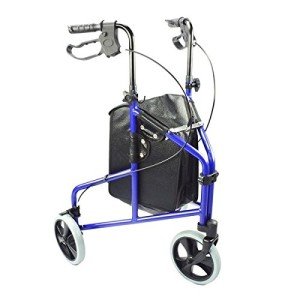
Rollators, also referred to as wheeled walkers, have become progressively popular among individuals seeking mobility help. These ingenious devices provide a combination of assistance, stability, and convenience, making them perfect for seniors and individuals with impairments. This short article checks out the functions, benefits, types, and factors to consider of rollators with wheels, in addition to often asked questions to assist you make a notified decision.
A rollator is a mobility gadget geared up with 3 or 4 wheels, hand brakes, and a frame designed for stability. Unlike conventional walkers, which need users to raise the device to move, rollators glide efficiently, permitting users to walk naturally while getting assistance. The majority of rollators likewise include a seat for resting, making them particularly useful for those who might tire quickly.

Rollators offer various advantages for individuals with limited mobility. Some of the crucial benefits include:
When considering a rollator, a range of choices are readily available to accommodate varied requirements:
Standard Rollators: Typically featured four wheels, larger frames, and a comfortable seat, making them ideal for most users.
Compact Rollators: Designed for indoor use or travel, these rollators are Lightweight 3 Wheel Rollator with Adjustable Handle, foldable, and frequently feature smaller sized frames.
Durable Rollators: Engineered for users who might require additional assistance, these rollators normally have a greater weight capability and a larger frame.
Three-Wheeled Rollators: More maneuverable than their four-wheeled equivalents, these rollators are ideal for navigating tighter spaces.
Before purchasing a rollator, there are a number of aspects that must be considered to guarantee the very best suitable for individual requirements:
Appropriate maintenance can prolong the life of a rollator and make sure safety throughout use. Here are some tips:
| Kind of Rollator | Wheel Count | Perfect Use | Weight Capacity | Mobility |
|---|---|---|---|---|
| Requirement Rollator | 4 | General mobility | 300 pounds | Moderate |
| Compact Rollator | 4 | Indoor/Travel | 250 pounds | High |
| Durable Rollator | 4 | Extensive use | 400 lbs | Low |
| Three-Wheeled Rollator | 3 | Tight spaces | 300 lbs | Moderate |
Q1: How do I choose the ideal rollator for my needs?
A1: Consider factors such as your height, weight, and where you'll mostly use the rollator (indoor vs. outdoor). A trial at a mobility store might also assist you find a comfy fit.
Q2: Are rollators challenging to maneuver?
A2: Most rollators are designed for ease of use, and with practice, users generally discover them easy to maneuver, specifically those with rotating wheels.
Q3: What is the typical cost of a rollator?
A3: Prices can vary substantially, from approximately ₤ 70 for fundamental models to over ₤ 300 for high-end or specialized designs.
Q4: Can rollators be utilized outdoors?
A4: Yes, many rollators are created for both indoor and outdoor use. However, picking one with larger wheels can boost stability on uneven terrain.
Q5: How do I keep my rollator?
A5: Regularly check the brakes and wheels for wear, tighten any loose parts, and clean the frame occasionally to make sure safety and durability.
Rollators with wheels are vital mobility aids that promote self-reliance and security for users. By understanding the features, benefits, and upkeep of rollators, individuals can make educated choices about their mobility needs. With the ideal rollator, users can enjoy better mobility, self-confidence, and quality of life.
No Data Found!

